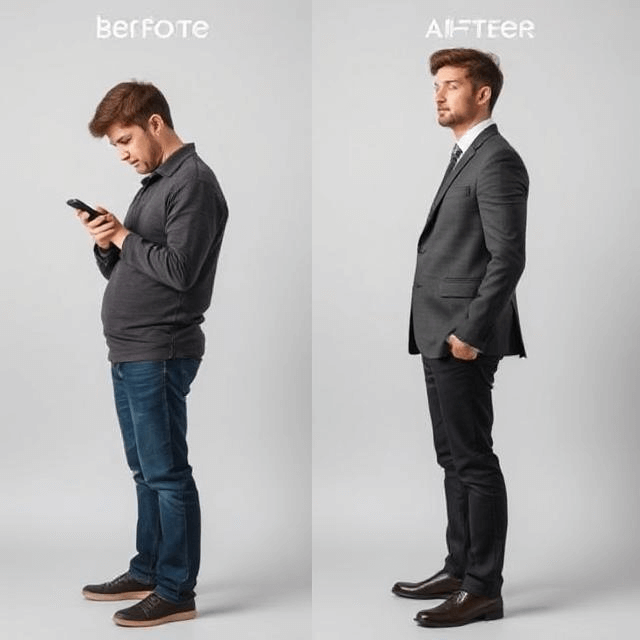Posture & Confidence: Stand Tall, Look Powerful
In a world where first impressions are made in milliseconds, your posture can speak volumes before you even utter a word. The way you carry yourself reflects your confidence, your mindset, and even your credibility. Whether you’re walking into an interview, presenting in front of a crowd, or meeting someone new, your posture can be the silent ambassador of your personal brand. This comprehensive guide dives deep into the intricate relationship between posture and confidence, giving you practical insights, backed by science and psychology, on how to stand tall and look powerful.
Table of Contents
- Introduction
- The Science Behind Posture
- How Posture Influences Confidence
- Posture and First Impressions
- Psychological Studies on Posture and Confidence
- The Role of Body Language
- Common Postural Mistakes and Their Effects
- Exercises to Improve Posture
- Daily Habits for Better Posture
- Posture at Work and Home
- Power Poses: Fact or Fiction?
- Posture in Public Speaking
- Cultural Perspectives on Posture
- Posture and Health: The Long-Term Benefits
- Conclusion
1. Introduction
Have you ever noticed how people who appear confident often stand or sit upright, shoulders back, head high? That isn’t just by chance. Posture and confidence are intricately connected. Good posture doesn’t just make you look more confident — it actually makes you feel more confident.
2. The Science Behind Posture
Posture refers to the position in which you hold your body when standing, sitting, or lying down. It’s maintained by the coordination of your muscles and skeletal structure. When your posture is aligned, your body is in balance, reducing the strain on muscles and ligaments.
Proper posture ensures optimal blood flow, organ function, and even hormone regulation. Scientific research has shown that upright posture can influence the release of hormones like testosterone (associated with confidence) and cortisol (linked to stress).
3. How Posture Influences Confidence
Confidence isn’t just a mental state — it’s deeply physiological. When you stand tall, your body sends signals to your brain that you are in control. This leads to the production of power hormones and a reduction in stress hormones.
When you slouch or hunch, your body interprets that position as one of defeat or submission. As a result, you feel less confident, more anxious, and unsure of yourself. Conversely, standing tall with open body language signals dominance, alertness, and a sense of purpose.

4. Posture and First Impressions
We judge people in the first 7 seconds of meeting them. Before a person even speaks, we gather visual cues — their dress, expressions, and most importantly, posture. A tall, aligned posture conveys assurance, strength, and credibility.
Someone with poor posture may be perceived as lazy, unmotivated, or even dishonest. This perception can affect job interviews, dating, networking, and leadership opportunities.
5. Psychological Studies on Posture and Confidence
Several studies back up the link between posture and psychology:
- Amy Cuddy’s Harvard Study showed that holding a “power pose” for just two minutes can significantly increase testosterone and decrease cortisol.
- A 2015 study published in Health Psychology found that upright posture in stressful situations improved self-esteem and mood.
- Ohio State University research concluded that people who sat upright were more confident in the statements they wrote than those who slouched.
These findings suggest that posture can directly influence not only how others perceive you, but how you perceive yourself.
6. The Role of Body Language
Posture is a key component of body language, which makes up over 55% of communication. Open, expansive body language, such as standing with feet apart and arms relaxed, communicates confidence. Closed-off body language like crossed arms, looking down, or slouching signals insecurity or discomfort.
Confident body language helps establish trust, assertiveness, and leadership. Practicing awareness of your posture helps you become more conscious of your presence in social interactions.
7. Common Postural Mistakes and Their Effects
- Forward Head Posture: Often caused by tech use. Leads to neck pain and a perception of weakness.
- Rounded Shoulders: Common in desk jobs. Makes you look closed off and insecure.
- Slouched Back: Creates a lazy, inattentive appearance.
- Crossed Arms: Often read as defensive or disinterested.
Correcting these can dramatically improve how others view you — and how you feel.
8. Exercises to Improve Posture
- Wall Angels: Stand with your back against a wall, arms at 90 degrees. Raise and lower slowly. Helps with shoulder alignment.
- Planks: Strengthens your core, essential for holding a straight back.
- Chin Tucks: Aligns the neck and strengthens upper spine support.
- Cat-Cow Stretch: Improves spine flexibility.
- Shoulder Blade Squeezes: Retrains your muscles to stay upright.
Practicing these exercises daily can help realign your posture and develop muscle memory.
9. Daily Habits for Better Posture
- Use ergonomic chairs and desks.
- Take breaks from screens every 30 minutes.
- Set posture reminders on your phone.
- Sleep on your back with a pillow that supports your neck.
- Stand up while taking calls or during meetings.
These small adjustments can lead to massive improvements over time.
10. Posture at Work and Home
In today’s digital world, we spend hours sitting. Poor posture habits can quickly develop. Create a setup where:
- Your screen is at eye level.
- Feet are flat on the ground.
- Wrists are neutral when typing.
At home, use cushions for lumbar support. Consider posture-correcting chairs or standing desks.
11. Power Poses: Fact or Fiction?
Amy Cuddy’s “power posing” concept became viral, but it faced criticism over reproducibility. Still, many agree that power posing has psychological benefits. Holding a strong pose — hands on hips, feet apart, chin up — can boost feelings of authority and self-control.
While the hormonal effects are debated, the emotional impact remains valid.
12. Posture in Public Speaking
Great speakers know the power of posture. Standing tall with an open stance commands attention and trust. Nervous gestures like fidgeting or shifting weight distract the audience. Instead, maintain strong posture, use purposeful gestures, and make consistent eye contact.
Practicing posture while rehearsing your speech can enhance delivery and audience reception.
13. Cultural Perspectives on Posture
Different cultures interpret posture differently:
- In Japan, bowing with a straight back shows respect.
- In the West, standing tall symbolizes confidence.
- In yoga, posture (asana) is linked to mental clarity and energy.
Being culturally aware of posture norms is important when interacting in diverse environments.
14. Posture and Health: The Long-Term Benefits
Good posture isn’t just about looking confident — it’s vital for long-term health. Benefits include:
- Reduced risk of back and neck pain
- Better digestion
- Improved breathing
- Enhanced focus and energy
- Lower fatigue
It also reduces the risk of developing musculoskeletal problems and improves your overall physical performance.
15. Conclusion
Posture is not just a physical stance — it’s a reflection of your inner world. It affects how you feel, how you’re perceived, and how successful you become. By improving your posture, you’re not just standing taller — you’re stepping into your power.
Make posture a priority in your personal development. With awareness, practice, and consistency, you’ll unlock a new level of confidence and presence. Stand tall — and let the world see the best version of you.







